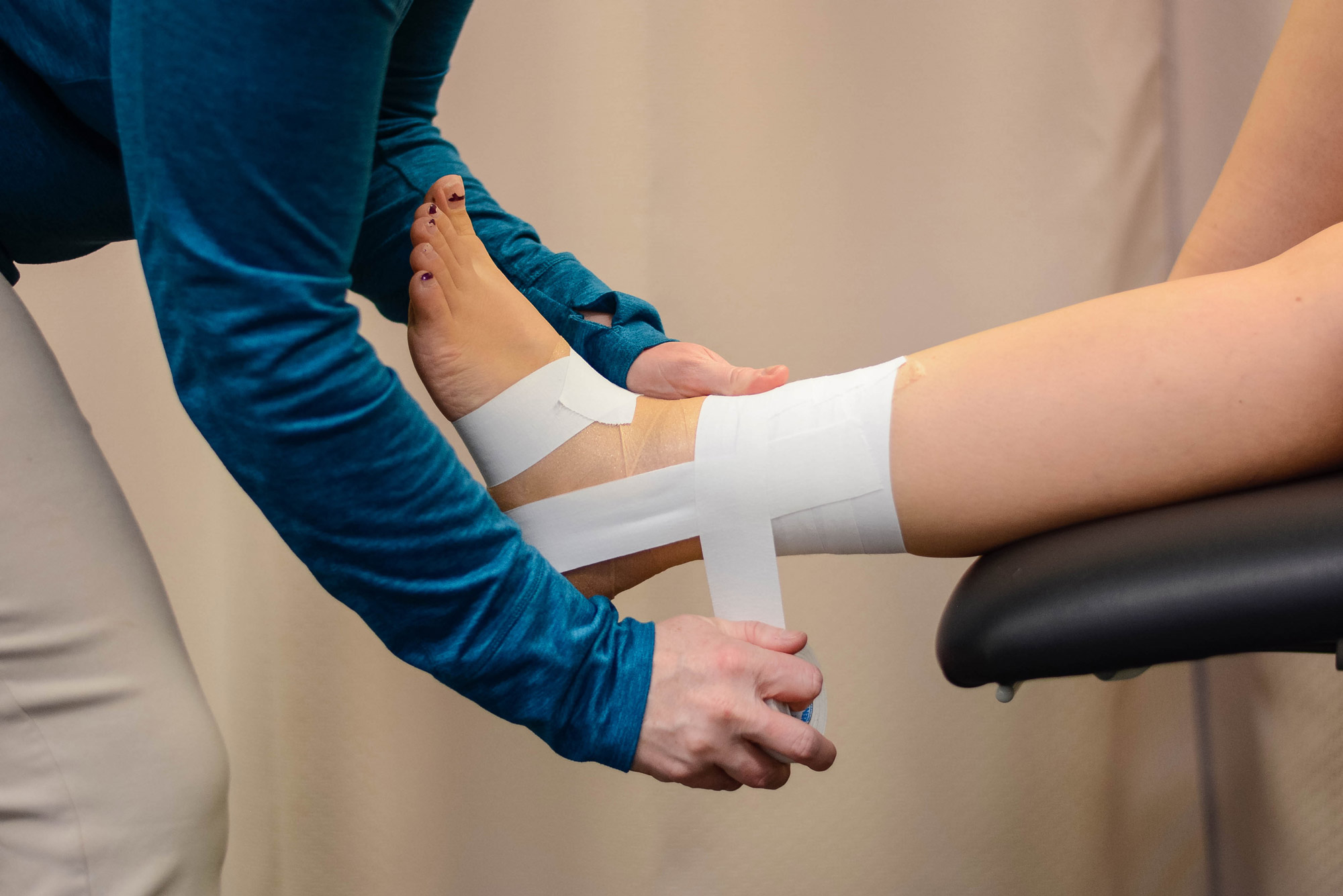
Ankle Sprain
Understanding Ankle Sprains
An ankle sprain is an injury that occurs when you roll, twist, or turn your ankle in a way that stretches or tears one or more of the ligaments in the ankle. Ligaments are responsible for stabilizing your ankle joint and preventing excessive movement, so when it is damaged, you can experience pain and difficulty walking. Different factors can affect the severity of your sprain, such as:
- How severely the ligament has been stretched
- If the ligament has been partially or completely torn
- The number of ligaments that have been damaged
It's important not to confuse an ankle sprain with an ankle strain. An ankle strain is a condition in which the muscles and tendons in the ankle have been pulled or stretched too far.

Symptoms of an Ankle Sprain
The symptoms of an ankle sprain vary in intensity from person to person. If you've sprained your ankle, you may notice symptoms such as:
- Popping sound or sensation at the time of the injury
- Pain
- Swelling
- Bruising
- Stiffness
- Difficulty walking
- Instability at the ankle
- Restricted range of motion
If you've had a previous ankle sprain, your symptoms may be different. You may not have swelling or pain and may instead have a feeling of unsteadiness in the affected ankle.
In any event, sprains are serious injuries that should receive immediate attention for proper diagnosis and treatment. An untreated ankle sprain could lead to more serious conditions later in life, such as chronic ankle instability and arthritis in the ankle joint.
Find Relief for Your Ankle OUR ESCONDIDO, CA, PODIATRISTS CAN HELP
Though minor sprained ankles may be treated at home with over-the-counter pain medication and self-care measures, many cases require a medical evaluation to determine the severity of the sprain.
Drs. Jason Morris and Avanti Redkar at North County Foot & Ankle Specialists can determine the best course of action for your ankle sprain and return your ability to take part in daily activities as soon as possible.
If you have a sprained ankle and you require treatment, we invite you to fill out our contact form or call our Escondido, CA, practice to request an appointment with one of our board-certified podiatrists:
(760) 745-1226

"They all truly do care!" 5-Star Reviews
I’m posting this review after my second visit with this team. Irma and Tisha at the front desk are absolutely amazing, very sweet, and helpful! Dr. Morris is extremely patient, helpful, and explained everything (which I appreciate). It is clear that they all truly do care! I highly recommend North County Foot Ankle Specialists to anyone who wants to protect their body the right way with the right help!
View on GoogleI was pleasantly surprised the doctor was female. I have has several appointments and she is professional, listens to all my concerns and problems. She explains everything to me nicely and makes everything understandable and gentle treatment. I am so glad this practice was recommended to me and I highly recommend it to anyone that wants to be treated respectfully.
View on GoogleDiagnosing an Ankle Sprain At Our ESCONDIDO Practice
Physical Examination
Your ankle, foot, and lower leg will be examined by one of our doctors in Escondido, CA. They will check for points of tenderness, test your ankle's range of motion, and determine which positions cause pain or discomfort.
Magnetic Resonance Imaging (MRI)
If your doctor thinks there may be severe damage to the ligaments, cartilage, or bone, they may order an MRI or other advanced imaging tests once the swelling and bruising have subsided.
X-Rays
Severe ankle sprains can have symptoms similar to those of a fracture. Because of this, your doctor may prescribe an X-ray to rule out a fracture.
Ultrasound
An ultrasound will allow your doctor to observe the ligaments and other inner structures of your ankle as the ankle is being moved.
Ankle Sprain Classification
Grade One (Mild)
- Slight stretching and tearing of the ligament
- Mild tenderness, swelling, and bruising
- Typically no pain when weight-bearing
- No instability
- May take one to three weeks to heal
Grade Two (Moderate)
- Partial tearing of the ligament
- Moderate tenderness, swelling, and bruising
- Mild pain when weight-bearing
- Mild instability
- May take four to six weeks to heal
Grade Three (Severe)
- Complete tearing of the ligament
- Severe tenderness, swelling, and bruising
- Severe pain when weight-bearing
- Significant instability
- May take several months to heal
Treatment Options for a Sprained Ankle
Our podiatrists in Escondido, CA, can treat most sprained ankles through non-surgical methods. They may use a treatment program that requires three phases:

Phase One: Healing
- Rest, immobilize, and elevate the ankle
- Apply ice to the affected area
- Use an elastic wrap to control swelling
- Take over-the-counter pain medication
- Use a brace, boot, or small cast

Phase Two: Rehabilitation
- Discontinue ankle immobilization
- Attend physical therapy regularly
- Practice at-home stretches and exercises to strengthen the ankle, improve range of motion, and restore balance

Phase Three: Return to Normalcy
- Gradually advance your strength exercises
- Slowly return to your pre-injury activities, starting with those that don't require much ankle movement
- Wear ankle tape or braces when returning to certain work activities and sports
This program is often enough to heal a sprained ankle of any grade, but surgery may be required.
Treating Your Ankle Through Surgical Means
Our Escondido, CA, podiatrists will always consider conservative treatment options before anything else; however, they may recommend surgery in cases where the patient has a severe sprain, has a fracture, or non-surgical methods like physical therapy haven't been able to rehabilitate the ankle.
Surgery can repair a ligament that won't heal, reconstruct a ligament with tissue from another ligament or tendon, and tighten the ligaments on the outside of your ankle. If necessary, surgery can also remove loose fragments of bone or cartilage to restore functionality.
Who's At-Risk for Ankle Sprains?
Our patients in California lead active lifestyles, from hiking trails to surfing Pacific waves. Among the activities that can increase your risk of spraining your ankle:
- Participating in sports
- Walking or running on uneven surfaces
- Being in poor physical condition
- Having sustained a prior ankle injury
- Wearing footwear improper for the activity or terrain
You can lower your risk of spraining your ankle by warming up before physical activity, maintaining muscle strength and flexibility, and using an ankle support brace or tape if you've had a previous ankle injury.
"Great experience!"
Great experience! Comfortable orthotics that resolved by pain and would highly recommend to friends and family!
View on GoogleFriendly and professional office/nursing staff. Dr. Morris is very clear about procedures and expectations and very easy to understand. Appointments were always on-time. Highly recommended!
View on Google








